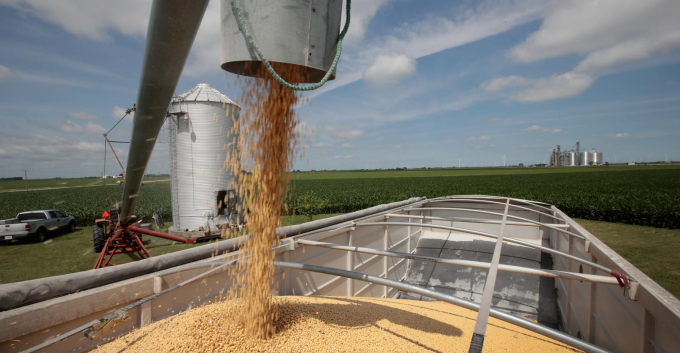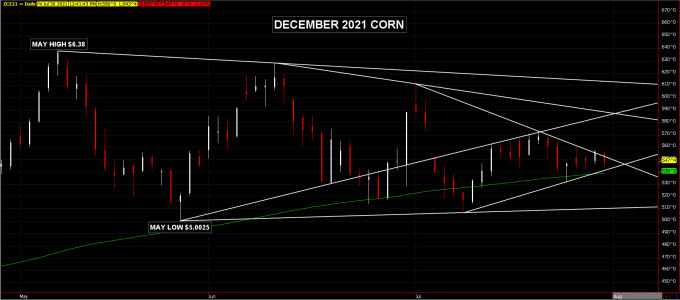November 28, 2025 | 02:28 GMT +7
November 28, 2025 | 02:28 GMT +7
Hotline: 0913.378.918
November 28, 2025 | 02:28 GMT +7
Hotline: 0913.378.918

Corn, soybean markets waiting for a reason to give up, just like someone treading water in the ocean. Photo: Farm Progress
July trade will show losses for new crop corn and soybeans to the tune of 43.25 and 49.75 cents respectively. On the week, corn ended 2.25 cents higher while soybeans were 2.5 cents lower. Turn on the radio or TV and the analysis will likely sound similar: “Corn and Soybeans are in a wedge” or “Things are just moving sideways.”
One brief look at a chart of either product will show you that both markets are in a period of indecision and have been so since May. A price chart of both corn and soybeans shows values since the month of May to illustrate this sideways trend:
Capitalize on the trend
While technical traders focus on the numerous trendlines that have formed over the last several months representing support and resistance -- and it’s easy to get caught up in these day to day moves -- one must realize that for the most part corn and soybean values haven’t done anything of long-term consequence. Last week’s blog by my business partner, Jim McCormick, discussed a way to capitalize on the sideways trend in corn. If you haven’t read it, I suggest you take few minutes to understand the concepts he described.
So, what does it mean that the markets keep seeing these rather large swings, in both directions, yet aren’t really going anywhere? They’re waiting. They’re waiting for help; they’re waiting for a reason to give up, just like someone treading water in the ocean.
In my column a month ago, we ran through several potential outcomes of the Quarterly Stocks and Planted Acreage report released at the end of June. As the past month has evolved, we have seen the excitement of the all-out weather market recede, yet neither corn nor soybeans have taken that as a cue to break support. Has July weather been enough to expect USDA to raise yield expectations on the balance sheet?
I don’t know the answer to that question, and neither does the trade -- yet.
August USDA report looms
August 12th will be the next data drop from WASDE and is likely to set the trend for yield adjustments moving forward. There has been an awful lot of talk about a record crop in the Eastern belt, and with that I won’t disagree. Can we have record national average yields and still see the balance sheet get tighter? For corn, yes but not likely. For soybeans, no. Let me explain.
Taking corn yield to 177.5 from 179.5 is still a new record, but we’d lose 170 mb of production from current estimates. This is where we could have a record yield and still see ending stocks reduced.
But being realistic, it’d likely be offset by additional carry-in from old crop netting nearly unchanged stocks. If the USDA punts on yield, we are still likely to see old crop carry-in move higher and stocks could move to 1.5 billion bushels – or more. A yield increase in conjunction with an old crop carry-in increase and we’re likely to be trading ending stocks that no longer warrant a $5 handle until we see export demand return.
Soybeans are a bit different story. It is highly unlikely to materialize in the August report, but if the trade eventually feels like a record yield is possible (I don’t think it is at this stage with the issues in the Northern Plains), we’ll be using a yield number that inherently must be higher than USDA’s current estimate by at least 1.1bu. per acre, and therefore stocks will have to be increased. There is no reason to believe USDA will reduce old crop stocks at this point, but if they are below the current USDA estimate it likely won’t be until the September Quarterly Stocks report when we find out. August weather is of the utmost importance to soybean yield and, with stocks as tight as they are, there’s still plenty of potential for fireworks in the weeks to come.
Brazil’s impact on U.S. markets

We at AgMarket.Net feel that USDA could be low on their new crop export demand estimates, especially for corn based on recent Brazilian crop reductions. We also feel, based on how long it took the USDA to recognize the Chinese buying program a year ago, that the government will be slow to add export demand back into the balance sheets until they have no choice.
In this scenario, markets are likely to go looking for demand at lower levels. December corn is still roughly 50 cents above the May low and November Soybeans are still over a dollar above the June low. We can identify that $5 has become critical support for corn and we feel the $13 July low is worth protecting for November soybeans.
(Farm Futures)

(VAN) A new study reveals how the simultaneous effects of ocean acidification, salinity and loss of oxygen are making the world more fragile.

(VAN) Hopes are growing that the creation of the first 3D turkey gut model could be a turning point in the battle against the virulent blackhead disease.

(VAN) Tyson, America’s biggest meat supplier, plans to shutter one of its largest beef processing plants as the industry continues to struggle with low cattle supplies and political pressure from Washington.

(VAN) New FAO study shows how digital solutions are empowering farmers and fishers to prevent losses and build resilient agrifood systems.

(VAN) Brazil's COP30 presidency pushed through a compromise climate deal on Saturday that would boost finance for poor nations coping with global warming but that omitted any mention of the fossil fuels driving it.

(VAN) Poultry farmers in the UK have been warned that they could face one of the worst winters yet for bird flu.

(VAN) Prices of main-crop paddy have risen sharply, with jasmine rice hitting 16,100 baht per tonne — the highest level in years.